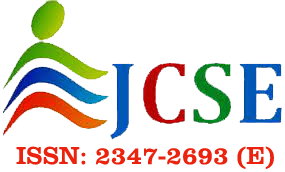CompNet : A novel Knowledge Graph Embedding Technique for Link Prediction
Kohsheen Tiku1 , Jayshree Maloo2 , R. Indra3
Section:Research Paper, Product Type: Journal Paper
Volume-8 ,
Issue-8 , Page no. 1-4, Aug-2020
CrossRef-DOI: https://doi.org/10.26438/ijcse/v8i8.14
Online published on Aug 31, 2020
Copyright © Kohsheen Tiku, Jayshree Maloo, R. Indra . This is an open access article distributed under the Creative Commons Attribution License, which permits unrestricted use, distribution, and reproduction in any medium, provided the original work is properly cited.
View this paper at Google Scholar | DPI Digital Library
How to Cite this Paper
- IEEE Citation
- MLA Citation
- APA Citation
- BibTex Citation
- RIS Citation
IEEE Citation
IEEE Style Citation: Kohsheen Tiku, Jayshree Maloo, R. Indra, “CompNet : A novel Knowledge Graph Embedding Technique for Link Prediction,” International Journal of Computer Sciences and Engineering, Vol.8, Issue.8, pp.1-4, 2020.
MLA Citation
MLA Style Citation: Kohsheen Tiku, Jayshree Maloo, R. Indra "CompNet : A novel Knowledge Graph Embedding Technique for Link Prediction." International Journal of Computer Sciences and Engineering 8.8 (2020): 1-4.
APA Citation
APA Style Citation: Kohsheen Tiku, Jayshree Maloo, R. Indra, (2020). CompNet : A novel Knowledge Graph Embedding Technique for Link Prediction. International Journal of Computer Sciences and Engineering, 8(8), 1-4.
BibTex Citation
BibTex Style Citation:
@article{Tiku_2020,
author = {Kohsheen Tiku, Jayshree Maloo, R. Indra},
title = {CompNet : A novel Knowledge Graph Embedding Technique for Link Prediction},
journal = {International Journal of Computer Sciences and Engineering},
issue_date = {8 2020},
volume = {8},
Issue = {8},
month = {8},
year = {2020},
issn = {2347-2693},
pages = {1-4},
url = {https://www.ijcseonline.org/full_paper_view.php?paper_id=5187},
doi = {https://doi.org/10.26438/ijcse/v8i8.14}
publisher = {IJCSE, Indore, INDIA},
}
RIS Citation
RIS Style Citation:
TY - JOUR
DO = {https://doi.org/10.26438/ijcse/v8i8.14}
UR - https://www.ijcseonline.org/full_paper_view.php?paper_id=5187
TI - CompNet : A novel Knowledge Graph Embedding Technique for Link Prediction
T2 - International Journal of Computer Sciences and Engineering
AU - Kohsheen Tiku, Jayshree Maloo, R. Indra
PY - 2020
DA - 2020/08/31
PB - IJCSE, Indore, INDIA
SP - 1-4
IS - 8
VL - 8
SN - 2347-2693
ER -
| |
|
|
| 422 | 1244 downloads | 234 downloads |
Abstract
A Knowledge Graph(KG) is a graph that contains information about anything and everything in the world, these graphs can be represented by plain-simple nodes and links. Knowledge Graph Embedding refers to attaining valuable information about every node present in the graph, essentially it could be defined as representing a node as a low-dimensional vector. Knowledge graph Embedding techniques have become an increasingly popular research topics. Despite all the efforts invested in creation and maintenance of knowledge graphs only contain a part of what it contains is true and it also still consists of missing facts. Prediction of these missing facts in scientific term can be known as Link Prediction. Several recent works use deep learning approaches to generate richer and more expressive embedding. However, observations show that the following methods are very expensive computationally. This paper proposes a novel approach for generating Graph Embeddings which can be used to perform the task of Link Prediction i.e. interpreting missing data. ?CompNet? uses a modified version of the complEx and Cluster-Graph Convolution Network (Cluster-GCN) algorithms. Laying out certain constraints on the ComplEx algorithm i.e. discussed in detail through this paper, can improve the time complexity drastically. ?CompNet? is tested on the large-scale dataset Freebase, wherein it out-performs the traditional approaches (translation based approaches and semantic search approaches) in terms of Mean Reciprocal Rank (MRR) and also utilizes low storage space
Key-Words / Index Term
Convolutional Neural Networks, ComplEx, Knowledge Graphs, Link Prediction, Graph Embedding
References
[1] Schlichtkrull, Michael & Kipf, Thomas & Bloem, Peter & Berg, Rianne & Titov, Ivan & Welling, Max. Modeling Relational Data with Graph Convolutional Networks. 10.1007/978-3-319-93417-4_38, 2018.
[2] Dai, Shaozhi & Liang, Yanchun & Liu, Shuyan & Wang, Ying & Shao, Wenle & Lin, Xixun & Feng, Xiaoyue. Learning Entity and Relation Embeddings with Entity Description for Knowledge Graph Completion. 10.2991/icaita-18.2018.49,2018.
[3] Antoine Bordes, Nicolas Usunier, Alberto GarciaDuran, Jason Weston, and Oksana Yakhnenko. Translating embeddings for modeling multirelational data. In C. J. C. Burges, L. Bottou, M. Welling, Z. Ghahramani, and K. Q. Weinberger, editors, Advances in Neural Information Processing Systems 26, Curran Associates, Inc., pages 2787? 2795, 2013.
[4] Feng, Jianlin. Knowledge Graph Embedding by Translating on Hyperplanes, 2014.
[5] TransH: Knowledge Graph Embedding by Translating on Hyperplanes. Zhen Wang, Jianwen Zhang, Jianlin Feng, Zheng Chen. AAAI , 2014.
[6] Nickel, Maximilian & Tresp, Volker & Kriegel, Hans-Peter. A Three-Way Model for Collective Learning on Multi-Relational Data.. Proceedings of the 28th International Conference on Machine Learning, ICML 2011. 809-816, 2011.
[7] Yang, Bishan & Yih, Wen-tau & He, Xiaodong & Gao, Jianfeng & Deng, li. (2014). Embedding Entities and Relations for Learning and Inference in Knowledge Bases. Thomas L., ?A Scheme to Eliminate Redundant Rebroadcast and Reduce Transmission Delay Using Binary Exponential Algorithm in Ad-Hoc Wireless Networks?, International Journal of Computer Sciences and Engineering, Vol.3, Issue.8, pp.1-6, 2017.
[8] ICML`16: Proceedings of the 33rd International Conference on International Conference on Machine Learning - Volume 48 Pages 2071?2080, June 2016
[9] KDD `19: Proceedings of the 25th ACM SIGKDD International Conference on Knowledge Discovery & Data Mining. Pages 257?266 , July 2019
[10] George Karypis and Vipin Kumar. 1998. A fast and high quality multilevel scheme for partitioning irregular graphs. SIAM J. Sci. Comput. 20, 1, 359?392, 1998.
[11] Improving Knowledge Graph Embedding Using Simple Constraints, Boyang Ding and Quan Wang and Bin Wang and Li Guo, year 2018.
[12] German Kruszewski, Denis Paperno, and Marco Baroni. 2015. Deriving Boolean structures from distributional vectors. Transactions of the Association for Computational Linguistics 3:375?388.
[13] A. Bordes, N. Usunier, A. Garcia-Duran, J. Weston, and O. Yakhnenko, ?Translating embeddings for modeling multirelational data,? in NIPS, pp. 2787?2795. 2013.
